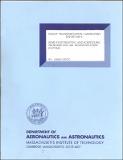| dc.contributor.author | Levin, Amos | en_US |
| dc.contributor.other | United States. Office of High-Speed Ground Transportation | en_US |
| dc.contributor.other | Massachusetts Institute of Technology. Flight Transportation Laboratory | en_US |
| dc.date.accessioned | 2012-01-06T22:05:48Z | |
| dc.date.available | 2012-01-06T22:05:48Z | |
| dc.date.issued | 1969 | en_US |
| dc.identifier | 11145205 | en_US |
| dc.identifier.uri | http://hdl.handle.net/1721.1/68063 | |
| dc.description | 1969 | en_US |
| dc.description | PB-174912 | en_US |
| dc.description | Includes bibliographical references (p. 124-125) | en_US |
| dc.description.abstract | The purpose of this work is to formulate and develop practicable solution methods to some important fleet routing, scheduling and fleet composition problems. These problems arise in the operation of air transportation systems like the operating domestic and international airlines. The problem of minimal fleet size to meet a variable schedule, which will be fixed when the system goes into operation, is formulated in several ways as Integer Linear Programs in 0-1 variables. The ILP's obtained are large scale programs and solved here by Land and Doig type Branch and Bound algorithms. The computational experiments with them, which were conducted with MPS/360, have been very sucessful and in the majority of cases, particularly when larger systems are solved, the algorithms terminated at the optimal integer solutions after a single iteration. The problem of scheduling and routing the minimal fleet is then formulated as an ILP which has exhibited equally successful computational results. The minimal single fleet-problem is extended to include some extraneous constraints on service frequencies between and at stations. Computational results with examples are provided. The problem of system design with and without a given fleet size is formulated. The problem of decomposition of the system into subsystems, each consisting of a single vehicle type is next formulated in several ways for several considerations. These formulations are also given as Integer Linear Programs. The first is proven to have at least one optimal integer solution. Computational experience with the application of the Land and Doig Branch and Bound algorithm to some of the other multi-fleet problems is also given. A computerized Airline Management Decision System which will use the models and solution methods developed in this work is briefly described in Appendix A. The Crew Scheduling Problem is also briefly discussed in this appendix since its solution procedures must be a part of such a Decision System. | en_US |
| dc.description.sponsorship | Office of High Speed Ground Transport, Dept. of Commerce | en_US |
| dc.format.extent | 125 p | en_US |
| dc.publisher | [Cambridge, Mass.] : Massachusetts Institute of Technology Flight Transportation Laboratory, [1969] | en_US |
| dc.relation.ispartofseries | FTL report (Massachusetts Institute of Technology. Flight Transportation Laboratory) ; R68-5 | en_US |
| dc.subject | Production scheduling | en_US |
| dc.subject | Airlines | en_US |
| dc.subject | Linear programming | en_US |
| dc.subject | Management | en_US |
| dc.title | Some fleet routing and scheduling problems for air transportation systems | en_US |
| dc.type | Technical Report | en_US |

